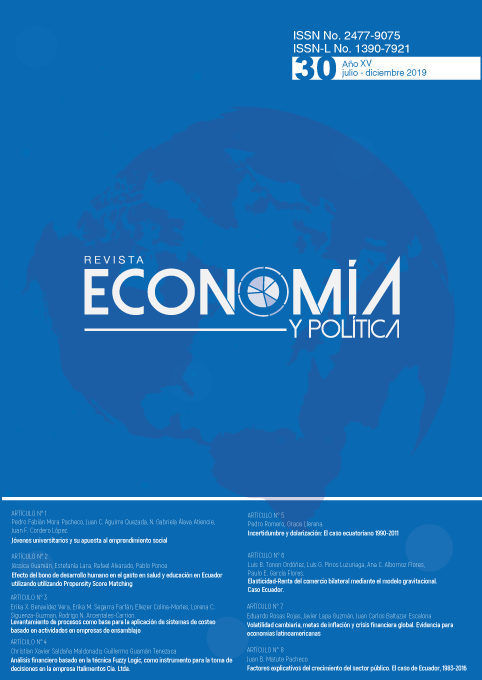Explanatory factors of public sector growth. The case of Ecuador, 1983-2016
DOI:
https://doi.org/10.25097/rep.n30.2019.08Keywords:
Economic Growth, Fiscal illusion, Public institutions, Public sector, Wagners lawAbstract
The following research examines the determining factors of the growth of the public sector in Ecuador in the period between 1983-2016, using five explanatory theories: Wagner's Law, economic internationalization, bureaucracy, fiscal illusion and political party ideology. The results reveal strong evidence that the growth of the public sector in Ecuador is linked political and institutional factors such as the the governing party's ideology and the effects of bureaucracy on the democratic system. On the opposite side of the spectrum, partial support for Wagner's Law and economic internationalization was found and no support for the theory that the growth of the public sector is due to fiscal illusion created by the tax system. The comparative analysis between countries presents evidence that the size of the public sector in Ecuador is oversized in relation to countries with similar levels of development.
Downloads
References
Asimakopoulos, S., & Karavias, Y. (2016). The impact of government size on economic growth. Economics Letters(139), 65-68.
Avella, M. (2009). Perspectivas de crecimiento del gasto público en Colombia, 1925-2003 ¿Una visión descriptiva à la Wagner, o à la Peacock y Wiseman? Revista de Economia Institucional, 11(20), 83-137.
Berry, W., & David, L. (Noviembre de 1984). The Measurement of Government Size: Implications for the Study of Government Growth. (T. U. Association, Ed.) The Journal of Politics, 46(4), 1193-1206.
Boix, C. (2001). Democracy, Development, and the Public Sector. (M. P. Association, Ed.) American Journal of Political Science, 45(1), 1-17.
Cameron, D. (1978). The Expansion of the Public Economy: A Comparative Analysis. The American Political Science Rev, 72(4), 1243-1271.
Cavicchiolia, M., & Pistoresi, B. (2016). Testing threshold cointegration in Wagner’s Law: The role of military spending. Economic Modelling, 59, 23 -31.
Foxley , A. (2012). La trampa del ingreso medio. El desafío de esta década para América Latina. Santiago de Chile: DIMACOFI.CEPLAN.
Garand, J. (1988). Explaining Government Growth in the U.S States. The American Political Science Review, 82(3), 837-849.
Gujarati, D. N., & Porter, D. C. (2010). Econometría (Quinta Edición ed.). México: McGRAW-HILL/INTERAMERICANA.
Hibbs, D. (1976). Industrial Conflict in Advanced Industrial Societies. (A. P. Associ, Ed.) The American Political Science Review, 70(4), 1033-1058.
Hibbs, D. (1977). Political Parties and Macroeconomic Policy. (A. P. Association, Ed.) The American Political Science Review, 71(4), 1467-1487.
Homi, K., & Gill, I. (2007). An East Asian reinaissance: Ideas for economic growth. Washington, DC: World Bank.
Jaén, M. (2004). Evolución contemporánea del Gasto Público en España. Almería: Servicio de Publicaciones de la Universidad de Almería.
Jara, C., & Umpierrez de Reguero, S. (2014). Evolución del Sector Público Ecuatoriano desde 1998 a 2013. Revista Enfoques: Ciencia Política y Administración Pública(22), 131-147.
Jetter, M., & Parmeter, C. (2014). Trade Openness and bigger governments: The role of country size revised. European Journal of Political Economics(37), 49-63.
Magazzimo, C. (2012). Wagner vs Keynes: Public spending and nacional income in Italy. Journal of Policy Modeling(34), 890-905.
Narayan, S., Narayan, B., & Kumar, P. (2012). Evidence of Wagner´s Law from Indian states. Economic Modelling, 29, 1548 - 1557.
Ochando, C. (1999). El Estado del Bienestar: Objetivos, modelos y teorías explicativas. Barcelona: Ariel S.A.
Pickering, A., & James, R. (2011). Ideology and the Growth of Government. The Review of Economics and Statistics, 93(3), 907-919.
Ram, R. (1987). Wagner's Hypothesis in Time-Series and Cross-Section Perspectives: Evidence from "Real" Data for 115 Countries. The Review of Economics and Statistics, 9(2), 194-204.
Rodriguez, D., Vanegas-Matínez, F., & Lima, S. (2013). La ley de Wagner versus la hipótesis keynesiana: El caso de México, 1950-2009. Investigación Económica(283), 69-98.
Santos, A. (2014). A Time Series and Panel Analysis of Government Spending and National Income. Munich Personal RePEc Archive (MPRA)(56994).
Sideris, D. (2007). Wagner’s Law In 19th Century Greece: A Cointegration and Causality Analysis. Working Paper(64).
Weil, D. N. (2006). Crecimiento Económico. Madrid: Pearson Education.
Downloads
Published
How to Cite
Issue
Section
License
The Journal declines any responsibility for possible conflicts derived from the authorship of the works that are published in it.
The University of Cuenca in Ecuador conserves the patrimonial rights (copyright) of the published works and will favor the reuse of the same ones, these can be: copy, use, diffuse, transmit and expose publicly.
Unless otherwise indicated, all contents of the electronic edition are distributed under a Creative Commons Attribution-NonCommercial-ShareAlike 4.0 International License.






